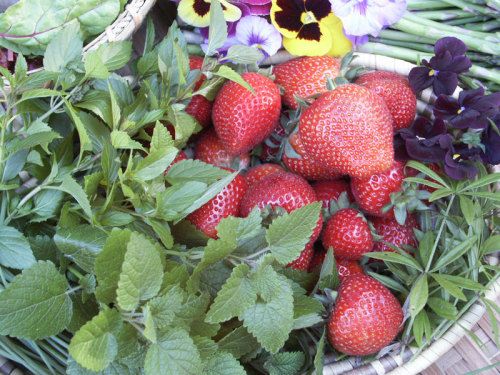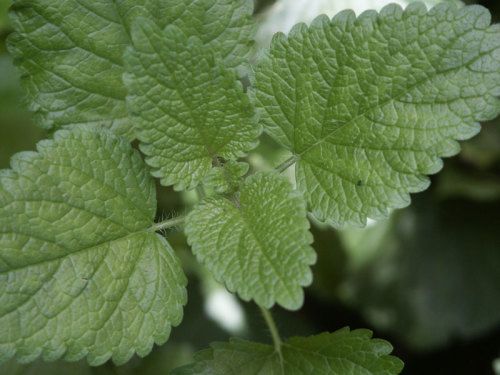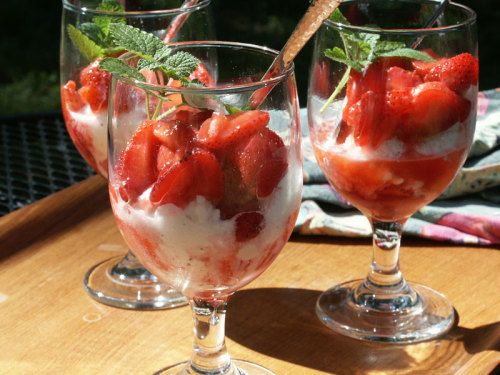
In most parts of the country our gardens are coming alive and we are rejoicing that spring is upon us. We delight as the first herbs appear in the garden and combine their flavors with seasonal fruits and vegetables like strawberries and asparagus. For the next few weeks, I will be featuring these herbal harbingers of spring with favorite seasonal recipes.
In the spring, when the soil is still wet and cold and the earth is awakening, we gardeners are anxiously awaiting the stirring signs of life. First to pop in the garden are the stalwart perennial herbs. These welcome harbingers of spring are chives, fennel, lemon balm, mint, sorrel, sweet woodruff, and the violas. These perennials are easy to grow and require similar growing conditions with the exception of sweet woodruff, which is a ground cover that prefers shade or partial shade. Not only are they pleasing to our eyes, but they refresh and awaken our palates. Get to know them and celebrate spring by using them in the kitchen!
| Balmy summer days will bring quiet cheer to gardens all and fragrant kitchens will recall Melissa’s promise of the spring. —Carolyn Dille & Susan Belsinger Herbs in the Kitchen |
|
My first selection to feature is Lemon Balm (Melissa officinalis). Lemon balm is native to Southern Europe, Asia, and North Africa. It’s a perennial, and it growns in Zone 4 to 9.
Lemon balm’s botanical name comes from the Greek word for bee, as the balm patch attracts large numbers of bees, especially when the plants are in bloom. The fragrance of lemon and sweet honey mingle in lemon balm’s leaves.
How to grow lemon balm
 |
|
| Lemon balm emerges in the spring. |
Lemon balm is easy to grow from seed, rooted cuttings, or by root division. It prefers light soil, but will adapt if some amendments are worked into heavier clay soils; soil should also be fairly fertile and well balanced. Balm thrives in full sun but can be grown in partially shaded areas. (The cultivars ‘All Gold’ and ‘Aurea’ have variegated and yellow foliage, and need some shade since the full hot sun tends to burn them.)
A member of the mint family, balm looks and grows much like mint, though it does not send runners. It will compete for space and is best planted next to other vigorous perennials that will hold their own against this sweet, yet invasive herb. Balm grows from 2 to 2-1/2 feet tall, bushing out laterally, so give each plant 2 feet all around.
Trim plants to help maintain their handsome bushy appearance. The hardy root system will survive the coldest winters if the plants are well mulched.
Culinary uses for lemon balm
Balm contributes a subtly sweet grassy flavor and a hint of lemon to a variety of foods. It is best used fresh with vegetables, light grains, baked fish and chicken. Its lemony sweet flavor is wonderful in desserts and beverages—in spring, I love to combine it with strawberries. Lemon balm goes well with light foods: green salads, fruit salads, and macerated fruits. The crushed fresh leaves steeped with iced tea or lemonade make a delicious hot weather beverage. If you live where it is cold in the winter, it is worth drying balm to make this hot tea, though the herb will have lost some of its aroma.
Add lemon balm very near the end of cooking, as its volatile oils are dissipated by heat. Its fragrance keeps fairly well in baked goods because its essence is captured in the cake batter or bread dough. Another way to capture its essence in by infusing the fresh leaves in milk or cream. Crush a handful of balm leaves into a saucepan with milk and bring it just to a simmer, remove from heat, cover and let cool to room temperature. Use this lemon-flavored milk to make pudding, tapioca, custard or add to cake batters.
For a fabulous dessert, make lemon balm flavored whipped cream to go with strawberries!
 |
 |
|
| Lemon balm can be infused in cream or milk. | Recipe: Strawberry and Lemon Balm Whipped Cream Parfaits |
Fine Gardening Recommended Products

A.M. Leonard Deluxe Soil Knife & Leather Sheath Combo
Fine Gardening receives a commission for items purchased through links on this site, including Amazon Associates and other affiliate advertising programs.

Lee Valley Mini Garden Shear Set
Fine Gardening receives a commission for items purchased through links on this site, including Amazon Associates and other affiliate advertising programs.

Gardener's Log Book from NYBG
Fine Gardening receives a commission for items purchased through links on this site, including Amazon Associates and other affiliate advertising programs.
























Comments
Log in or create an account to post a comment.
Sign up Log in